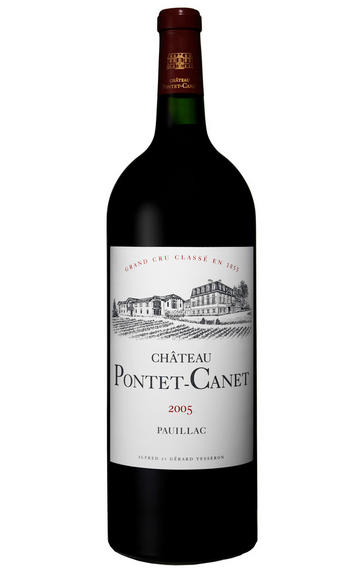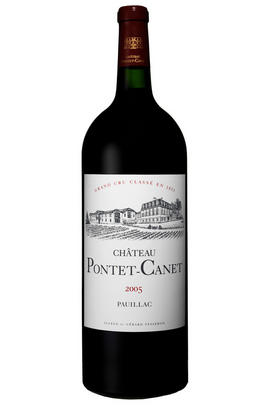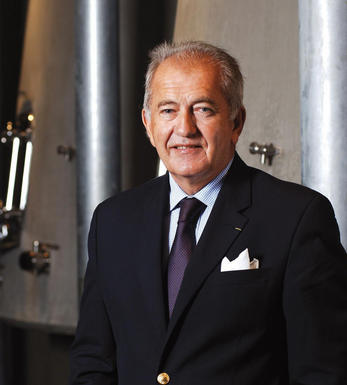
2005 Château Pontet-Canet, Pauillac, Bordeaux

Critics reviews
The 2005 Pontet-Canet is a heady, exotic wine. Inky dark fruit, mocha, chocolate, liquorice, spice and tobacco are front and centre. Readers will find an unabashedly opulent, full-throttle 2005 with quite a bit more oak influence and overall extraction than is the norm these days. Even so, the 2005 is a young, young wine with a bright future. This is one sexy Pauillac, that's for sure.
Drink 2025 - 2045
Antonio Galloni, Vinous.com (April 2021)
Tasted at the Pontet-Canet vertical in London, the 2005 Château Pontet-Canet has long been one of the stars of the vintage, and this might well be the best of over a dozen showings of this wine. However, do not expect ostentation on the nose. This is 2005, and like many wines of this vintage, even with considerable decanting, it remained broody and introspective on the nose, as if it is checking you out and seeing if you are worthy.
Once you have been accepted, it swings the doors open to reveal gorgeous scents of blackberry, briary and cassis fruit, perhaps a little more sous-bois than I have noticed compared to previous bottles. The palate is medium-bodied but dense and structured—a more masculine Pontet-Canet built for long-term ageing. Yet it retains marvellous freshness and vitality all the way through to the pencil-lead, quite saline finish.
I suspect that the 2009 Pontet-Canet is more approachable than the 2005, so heeding Robert Parker's sage advice, afford this up to ten years in your cellar and reap the rewards of patience.
Drink 2025 - 2050
Neil Martin, Wine Advocate (July 2016)
Possibly the youngest wine of all the 2005 Médocs in terms of its evolution, at age 10 the inky purple 2005 Pontet-Canet tastes more like a two-year-old wine. Loads of pure blueberry, blackberry and cassis fruit are present, along with a hint of liquorice and background oak. It is full-bodied, ripe, and excruciatingly fresh, vigorous and exuberant. This tour de force and a sensational effort rivalling the first growths. Give it another 5-10 years of cellaring, and drink it over the following 30-40 years.
Drink 2020 - 2065
Robert M. Parker, Jr., Wine Advocate (June 2015)
Rich, fruity blackcurrant nose, exuberant and pure. Very rich but not too dense, with vibrant fruit, formidable but overly chewy tannins. This has power and force, and a textured, layered finish. Very long.
Drink 2018 - 2035
Stephen Brook, Decanter.com
Always showing well, this bottle of 2005 Château Pontet Canet was just about pure perfection in a glass. Still youthful ruby/purple-hued, with a gorgeous core of pure cassis and darker currant fruits, it's full-bodied and has a stacked mid-palate, building tannins, and textbook Pauillac graphite, lead pencil, and subtle tobacco and cedar aromas and flavours.
It's a big, rich, powerful 2005 with flawlessly integrated tannins, remarkable purity, and a finish that won't quit. While it's still another 5-10 years away from being completely mature, it unquestionably offers incredible pleasure today.
Drink 2021 - 2031
Jeb Dunnuck, JebDunnuck.com (August 2021)
Good full ruby-red. Complex, enticing aromas of black raspberry, liquorice, minerals, bitter chocolate, lead pencil and pungent cedar; just this exotic side. Wonderfully silky, sweet and thick, with a powerful minerality framing the currant, graphite and spice flavours. This boasts superb inner-mouth energy and great length, with the full, ripe tannins totally enrobed by the wine's mid-palate richness. (My sample of the 2006 was old and tired, so I'll wait until next year to report on the finished wine; this was a star in the early going.)
Stephen Tanzer, Vinous.com (May 2008)
About this WINE

Chateau Pontet-Canet
Château Pontet-Canet is a large Pauillac estate that can trace its origins back to 1725, when Jean-François Pontet gave his name to the estate he had acquired. The wine was not château-bottled until 1972 and in 1975 the property was sold to Guy Tesseron, of the Tesseron family, one of the finest exponents of luxury, very old, aged Cognacs (Cognac Tesseron).
The Tesserons also own Château Lafon-Rochet in St-Estephe. Today, Château Pontet-Canet is owned and run by Alfred and Michel Tesseron.
Pontet-Canet's 78 hectares of vineyards adjoin those of Mouton Rothschild and are planted with Cabernet Sauvignon (63%), Merlot (32%) and Cabernet Franc (5%).
The Tesserons have vastly improved the quality of the Pontet-Canet wines which are now full-bodied and packed with ripe, chewy, black fruits and finely integrated tannins. The wines posseses marvellous ageing potential.
Pontet-Canet is classified as a 5ème Cru Classé.

Pauillac
Pauillac is the aristocrat of the Médoc boasting boasting 75 percent of the region’s First Growths and with Grand Cru Classés representing 84 percent of Pauillac's production.
For a small town, surrounded by so many familiar and regal names, Pauillac imparts a slightly seedy impression. There are no grand hotels or restaurants – with the honourable exception of the establishments owned by Jean-Michel Cazes – rather a small port and yacht harbour, and a dominant petrochemical plant.
Yet outside the town, , there is arguably the greatest concentration of fabulous vineyards throughout all Bordeaux, including three of the five First Growths. Bordering St Estèphe to the north and St Julien to the south, Pauillac has fine, deep gravel soils with important iron and marl deposits, and a subtle, softly-rolling landscape, cut by a series of small streams running into the Gironde. The vineyards are located on two gravel-rich plateaux, one to the northwest of the town of Pauillac and the other to the south, with the vines reaching a greater depth than anywhere else in the Médoc.
Pauillac's first growths each have their own unique characteristics; Lafite Rothschild, tucked in the northern part of Pauillac on the St Estèphe border, produces Pauillac's most aromatically complex and subtly-flavoured wine. Mouton Rothschild's vineyards lie on a well-drained gravel ridge and - with its high percentage of Cabernet Sauvignon - can produce (in its best years) Pauillac's most decadently rich, fleshy and exotic wine.
Latour, arguably Bordeaux's most consistent First Growth, is located in southern Pauillac next to St Julien. Its soil is gravel-rich with superb drainage, and Latour's vines penetrate as far as five metres into the soil. It produces perhaps the most long-lived wines of the Médoc.
Recommended Châteaux
Ch. Lafite-Rothschild, Ch. Latour, Ch. Mouton-Rothschild, Ch. Pichon-Longueville Baron, Ch. Pichon Longueville Comtesse de Lalande, Ch. Lynch-Bages, Ch. Grand-Puy-Lacoste, Ch, Pontet-Canet, Les Forts de Latour, Ch. Haut-Batailley, Ch. Batailley, Ch. Haut-Bages Libéral.

Cabernet Sauvignon Blend
Cabernet Sauvignon lends itself particularly well in blends with Merlot. This is actually the archetypal Bordeaux blend, though in different proportions in the sub-regions and sometimes topped up with Cabernet Franc, Malbec, and Petit Verdot.
In the Médoc and Graves the percentage of Cabernet Sauvignon in the blend can range from 95% (Mouton-Rothschild) to as low as 40%. It is particularly suited to the dry, warm, free- draining, gravel-rich soils and is responsible for the redolent cassis characteristics as well as the depth of colour, tannic structure and pronounced acidity of Médoc wines. However 100% Cabernet Sauvignon wines can be slightly hollow-tasting in the middle palate and Merlot with its generous, fleshy fruit flavours acts as a perfect foil by filling in this cavity.
In St-Emilion and Pomerol, the blends are Merlot dominated as Cabernet Sauvignon can struggle to ripen there - when it is included, it adds structure and body to the wine. Sassicaia is the most famous Bordeaux blend in Italy and has spawned many imitations, whereby the blend is now firmly established in the New World and particularly in California and Australia.


Buying options
Add to wishlist
Description
The 2005 Pontet-Canet is a heady, exotic wine. Inky dark fruit, mocha, chocolate, liquorice, spice and tobacco are front and centre. Readers will find an unabashedly opulent, full-throttle 2005 with quite a bit more oak influence and overall extraction than is the norm these days. Even so, the 2005 is a young, young wine with a bright future. This is one sexy Pauillac, that's for sure.
Drink 2025 - 2045
Antonio Galloni, Vinous.com (April 2021)
wine at a glance
Delivery and quality guarantee